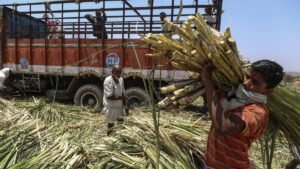
Why in news?
- The sugar industry in India stands as a cornerstone of the nation’s agro-based economy, impacting the lives of millions of sugarcane farmers and workers.
- With its recent achievements in production and exports, India has emerged as a global leader in sugar production, showcasing the industry’s resilience and potential for growth.
Significance of the Sugar Industry:
- The sugar industry stands as a cornerstone of India’s agricultural sector, exerting a significant influence on the nation’s socio-economic landscape. Here’s a detailed exploration of its importance:
- Employment Generation:
- The sugar industry serves as a major source of livelihood for approximately 50 million sugarcane farmers and around 5 lakh workers directly employed in sugar mills across the country.
- Sugarcane cultivation, harvesting, and processing activities provide employment opportunities to a vast rural population, contributing to poverty alleviation and socio-economic development in agrarian regions.
- Contribution to Rural Economies:
- The industry’s widespread presence in rural areas plays a vital role in bolstering rural economies by generating income and stimulating economic activities.
- Income earned from sugarcane farming and sugar mill operations circulates within local communities, driving demand for goods and services, and fostering economic growth in rural areas.
- Agricultural Sustainability:
- Sugarcane cultivation promotes agricultural sustainability by providing crop diversification and income stability to farmers.
- As a resilient and high-yielding crop, sugarcane contributes to soil fertility, water conservation, and carbon sequestration, enhancing the overall sustainability of agricultural practices.
- Contribution to GDP:
- The sugar industry’s substantial contribution to India’s Gross Domestic Product (GDP) underscores its economic significance.
- Beyond direct contributions, the industry stimulates downstream economic activities, such as transportation, logistics, and agro-processing, further amplifying its impact on GDP growth.
Geographical Distribution and Growing Conditions:
- Sugarcane cultivation thrives in regions characterized by temperatures between 21-27°C and hot, humid climates, with adequate rainfall ranging from 75-100 cm.
- Deep, rich loamy soils provide the ideal substrate for sugarcane growth. Major sugarcane-producing states include Maharashtra, Uttar Pradesh, and Karnataka, each contributing to India’s robust sugar output.
Recent Achievements and Global Standing:
- India’s sugar industry has witnessed remarkable growth in recent years, culminating in record-breaking production and exports.
- In the Sugar Season of 2021-22, Indian sugar mills achieved a historic milestone by producing a record 359 Lakh Metric Tons (LMT) of sugar, surpassing Brazil to become the world’s largest producer and consumer of sugar.
- Moreover, India ranks as the world’s second-largest exporter of sugar, bolstering its position in international markets.
Efforts to Enhance Export Competitiveness:
- India’s strategic initiatives and policy interventions aim to bolster export competitiveness in the sugar sector.
- Past challenges with predominantly exporting low-quality whites (LQW) of sugar prompted a shift towards promoting the quality and reliability of Indian raw sugar.
- Government efforts have yielded promising results in improving the perception of Indian sugar in international markets.
Comparative Advantage and Strategic Positioning:
- India capitalizes on its comparative advantage in sugar production by positioning itself as a reliable supplier of raw sugar during Brazil’s offseason.
- Shorter voyage times and lower freight costs to key markets like Indonesia give Indian raw sugar a competitive edge over counterparts from other countries.
- Indian mills offer raw sugar with superior polarisation levels, enhancing their attractiveness to global buyers.
Future Outlook and Growth Prospects:
- India’s sugar industry is poised for continued growth due to favorable climatic conditions, technological advancements, and rising demand.
- Diversification into ethanol production and value-added products, supported by government initiatives, is expected to further strengthen the industry’s resilience and competitiveness.
- Overall, the future outlook for India’s sugar sector is bright, with opportunities for sustained expansion and market leadership.
People also ask
Q1: What is the significance of the sugar industry in India?
Ans: The sugar industry plays a crucial role in India’s economy, impacting the livelihoods of millions of sugarcane farmers and workers. It is the second-largest agro-based industry in India after cotton.
Q2: How does India rank globally in sugar production, consumption, and exports?
Ans: India has emerged as the world’s largest producer and consumer of sugar. Additionally, it is the second-largest exporter of sugar globally.
Q3: What challenges did India face in enhancing its sugar export competitiveness?
Ans: India historically faced challenges in exporting low-quality whites (LQW) of sugar, limiting its penetration into international markets.
Q4: How has India improved its export competitiveness in the sugar sector?
Ans: India has focused on promoting the quality and reliability of its raw sugar, leading to promising results in international markets.